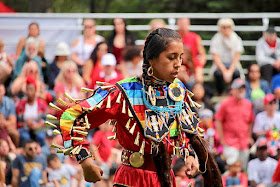The coronavirus has now arrived in many Native American communities. In an online strategy, Native women are working to heal their communities through virtual jingle dress dances. Umpaowastowin -- or Pat Northrup, as she's known in English, arranged an event and someone posted it on Facebook with the hashtag #jinglehealing. "Wear your jingle dress at home and be connected," the posting said. "Remember the reason we were given this dance."
According to Dan Kraker's coverage on Minnesota Public Radio, Native American women from Pennsylvania to Nebraska to Ontario to Northrup's apartment in northern Minnesota joined in. "This isn't just an Anishinaabe prayer. This is an "all-people-prayer," said Northrup, 70, who is Dakota, widow of the late Ojibwe author Jim Northrup. "The virus isn't going to have prejudice," she said. "It will affect all people. So that's what the prayers are for."
According to Dan Kraker's coverage on Minnesota Public Radio, Native American women from Pennsylvania to Nebraska to Ontario to Northrup's apartment in northern Minnesota joined in. "This isn't just an Anishinaabe prayer. This is an "all-people-prayer," said Northrup, 70, who is Dakota, widow of the late Ojibwe author Jim Northrup. "The virus isn't going to have prejudice," she said. "It will affect all people. So that's what the prayers are for."
Michele Hakala-Beeksma also danced, but in Duluth. "We literally say that dancing is prayer. That every step you take is prayer," she said. Hakala-Beeksma, a member of the Grand Portage Band of Lake Superior Ojibwe, started dancing about 15 years ago. She sewed about 150 copper cones on to her purple dress herself. "That tinkling sound, that kind of sounds like water, like rain -- that's the healing part that comes in. When you become a jingle dress dancer, there's a responsibility that comes with it. You're dancing for the healing of your people," she said.
The jingle dress dance originated with the Ojibwe people, or Anishinaabe, during the 1918 Spanish flu pandemic. There are different versions of the story about how the dance began. But they all include a little girl who was very sick. Her father had a dream about a dance that would make her better. She wore a dress lined with rows of silver cones. The sound of the jingles healed her. The sacred dance has since been taken up by women throughout Indian County, after it spread through the pow wow circuit in the 1980s.
Ojibwe women were defying the U.S. government when they developed the dance. At the time, the government forbade ritualistic dancing on reservations. So a century after that first pandemic when they danced as a prayer for healing, women from Minnesota and Wisconsin, Utah and Colorado, Kentucky and all around Canada -- danced again, praying for healing.
Photo by JMacPherson


No comments:
Post a Comment